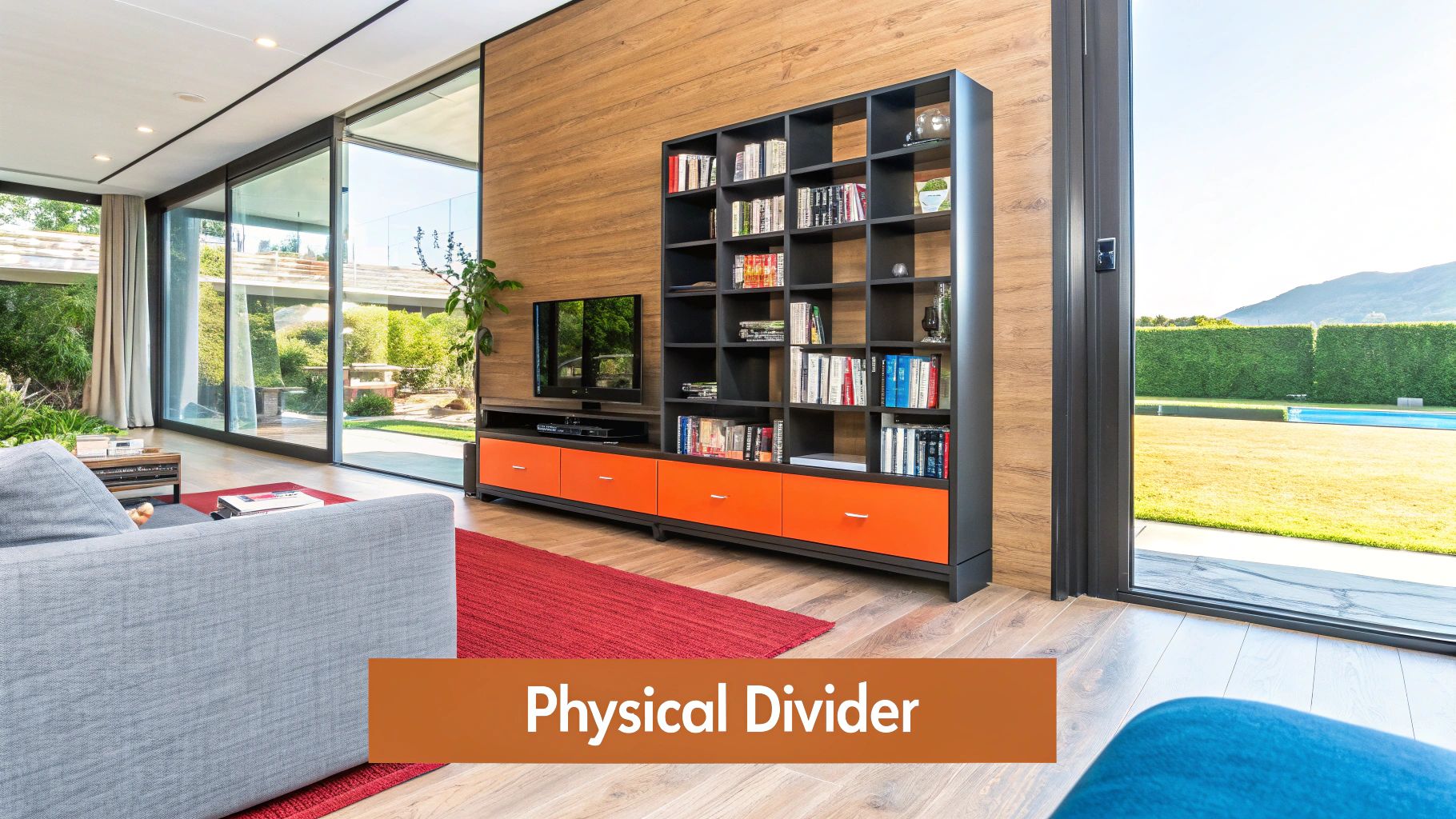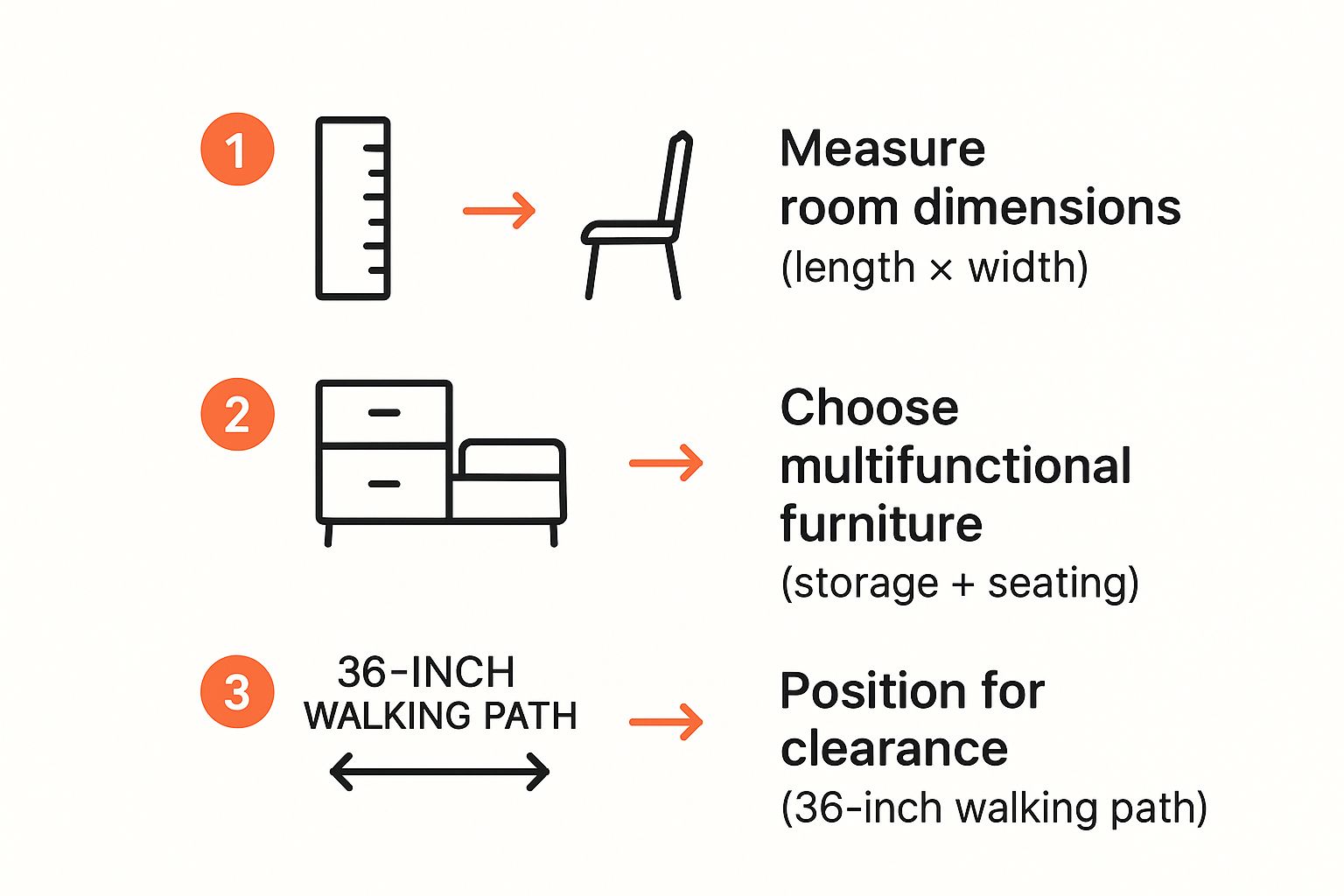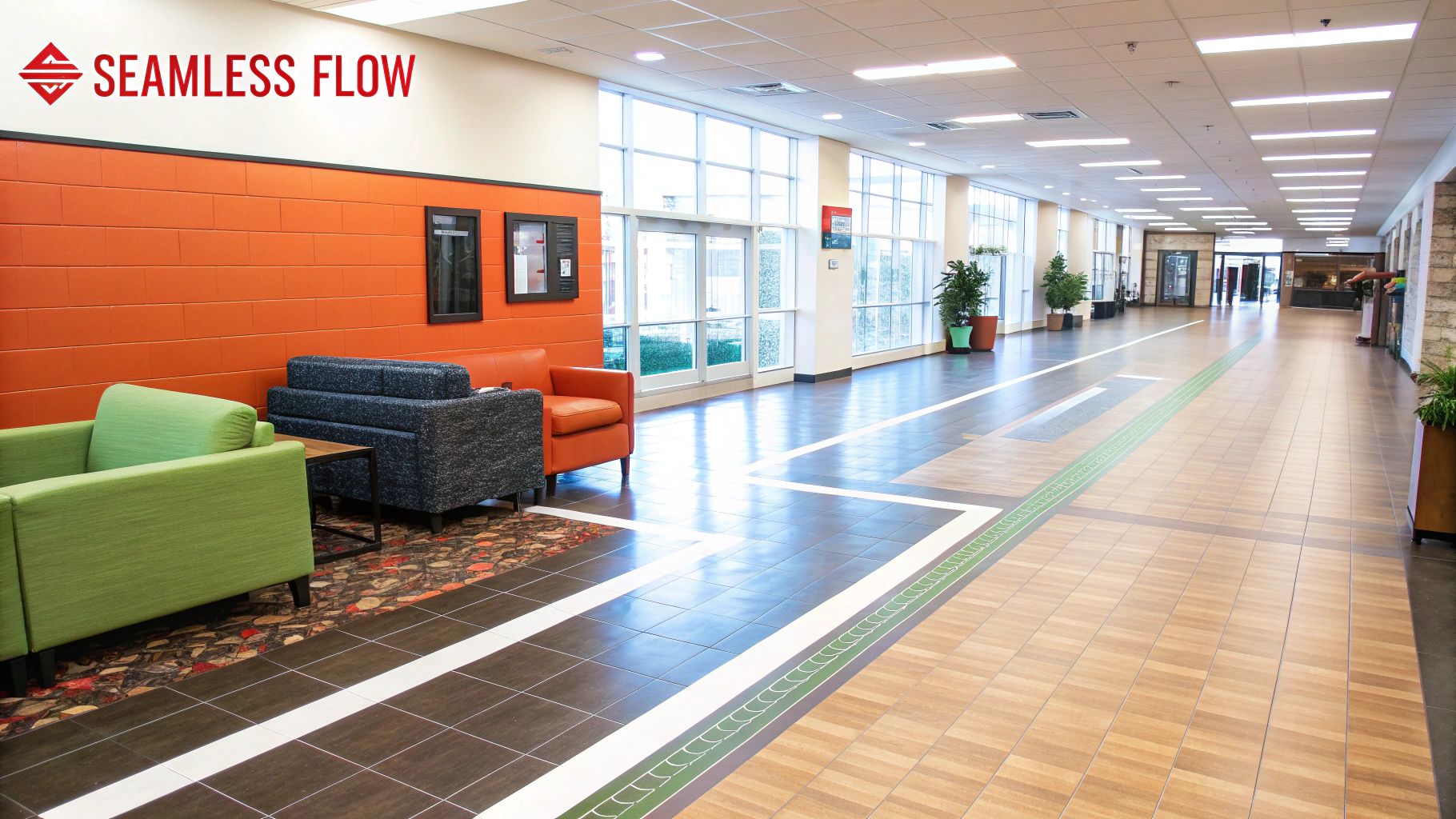-
CALL US:
- (866) 952-3456
Before you even think about buying a screen or a shelving unit, you have to have a plan. This is easily the most critical part of successfully dividing a room. We’re talking about more than just measurements; this is about carving out two distinct, functional zones that feel like they were always meant to be there and actually make your daily life better.
Jumping the gun and buying a divider without a clear strategy is a recipe for frustration. You end up with a cramped walkway, a new space that’s perpetually dark, or a layout that just feels off. A great room division starts with taking a hard look at the space you already have.
First, just observe the room's natural flow. Where do people walk most often? Sketching out these high-traffic paths is essential. You’ve got to make sure your new layout doesn't create an awkward bottleneck or a frustrating dead end.
For example, if you’re trying to create a home office in the corner of your living room, the last thing you want is for your new divider to block the main path from the sofa to the kitchen. A quick, simple sketch of the room with a few arrows can help you avoid this classic mistake.
Next up, get really specific about the purpose of each new zone. What exactly is going to happen in each area? A cozy sleeping nook has totally different requirements than a functional workspace where you need to focus.
The type of divider you pick should solve a specific problem. If you’re in a smaller urban apartment, you’re probably looking for something that offers both division and much-needed storage.
This is exactly why modular room dividers have become so popular. In fact, between 2018 and 2023, sales for these kinds of versatile solutions grew by about 8.3% annually in the U.S. alone, all driven by the growing need for space-efficient living.
A quick look at common room divider types can help you choose the best fit for your space, budget, and how much of a DIY project you're up for.
| Divider Type | Ideal Use Case | Typical Cost | Installation Effort |
|---|---|---|---|
| Shelving Unit | Creating division with storage (e.g., books, decor) | $100 – $500+ | Low to Medium |
| Curtain/Drapes | Soft, flexible division; great for sleeping nooks | $50 – $200 | Low |
| Folding Screen | Temporary and portable privacy; very flexible | $75 – $300 | None |
| Sliding Doors | A more permanent, structured division | $500 – $2,000+ | High (often requires professional help) |
| Glass Partition | Divides space without blocking light; modern look | $800 – $3,000+ | High (professional installation recommended) |
Ultimately, finding the right divider comes down to understanding what you need the new space to do for you.
A well-placed divider does more than just split a room; it multiplies its potential. The goal isn't to shrink your space but to make every square foot work smarter for you.

If you're renting or just someone who likes to change things up, non-permanent dividers are your best friend. These solutions let you divide a room without leaving a single nail hole, giving you a kind of flexibility that permanent walls just can't offer.
The trick is to think beyond a simple folding screen. You can get really creative with furniture and other elements to create separations that are both functional and stylish.
One of the cleverest ways to divide a room is with furniture you already have—or need anyway. A strategically placed shelving unit, for example, pulls double duty by creating a visual barrier while also giving you much-needed storage. This is a key idea behind a lot of great space-saving furniture ideas, where every piece serves more than one purpose.
A few ideas to get you started:
For a more industrial or minimalist vibe, you can also get creative with other materials. I've seen some really cool, adaptable partitions made with modular mesh panels that define zones without any permanent construction.
Curtains offer a soft, versatile, and often pretty inexpensive way to partition a space. The way you hang them and the fabric you choose will completely change the final look and feel.
A ceiling-mounted track system gives you a seamless, almost built-in look that can even make a room feel taller. It lets the curtain glide smoothly from wall to wall, offering a complete separation whenever you need it. This is a great solution for sectioning off a bedroom in a loft.
If you can't drill into the ceiling, a simple tension rod is the ultimate renter-friendly option. It requires zero drilling and can be installed in minutes between two walls—perfect for creating a temporary guest space or a cozy reading corner.
The fabric you choose is just as important as the hardware. Sheer linen will filter light and maintain brightness, while a heavy velvet or blackout material will provide maximum privacy and even some sound dampening.
Not every room divider needs to be a solid object. Sometimes, all you need is a subtle suggestion of separation to make a space feel more organized and intentional.
A cluster of tall plants, like snake plants or fiddle leaf figs, can form a beautiful, living wall. This organic approach adds life and texture to your room while gently guiding the eye and defining a specific area, like a meditation corner.
And of course, there are folding screens. They're a classic for a reason! They are completely portable, come in countless styles from ornate to minimalist, and can be adjusted, moved, or stored away in seconds. This makes them perfect for hiding a cluttered workspace at the end of the day or adding a touch of privacy when guests are over.

Sometimes, a bookshelf or a curtain just doesn't cut it. When you need a more solid, architectural answer for dividing a room, it’s time to look at semi-permanent and structural solutions. These options definitely require more commitment, but they deliver a much more integrated and lasting feel.
Think of these as the middle ground between plopping down a piece of furniture and calling in a construction crew. They’re less like simple accessories and more like intentional architectural elements that can seriously improve how a room works for you.
It’s no surprise that sliding barn doors have become so popular. They really do offer the best of both worlds: you can slide them shut for total privacy or open them up to get that open-concept vibe back in an instant. Best of all, they don’t need any floor space to swing open, which makes them a fantastic choice for tighter spots.
Imagine using a barn door to separate a primary bedroom from its en-suite bathroom, or to hide a messy playroom from the main living area. They’re also perfect for creating a home office that you can close off completely at the end of the workday. Installation involves mounting a track above the doorway—a project that’s very doable for a confident DIYer with the right tools.
For a division that’s truly permanent and solid, you can’t beat a partial wall. This is a structural approach, perfect when you need a sturdy barrier that can actually support things like shelving, artwork, or even a wall-mounted TV. A half-wall, for example, is a classic way to separate a kitchen from a dining area without completely killing the sightlines, keeping the space social and open.
Building a partial wall is a bit more involved, but the process is straightforward:
This is a bigger project, for sure. You'll need some basic carpentry skills and tools like a saw, drill, and level. But the payoff is a divider that feels like an original, seamless part of your home’s architecture.
A well-constructed half-wall does more than just divide a space. It adds real architectural interest and value to your home, defining an area while providing a functional surface.
What if you want to create separation but don't want to sacrifice all that beautiful natural light? Interior glass partitions are an incredibly elegant and modern solution. They’re especially effective for home offices, giving you excellent sound dampening while keeping the space feeling bright and connected to the rest of the house.
These partitions come in all sorts of styles, from sleek, minimalist frames to those cool, industrial-inspired black steel grids. While some modular systems are designed for DIY installation, getting that flawless, professional finish often means calling in an expert, especially for bigger or more custom setups.
From a cost perspective, these architectural choices can vary quite a bit. A permanent drywall wall might cost $10 to $25 per square foot. High-quality modular dividers, like glass systems, can run anywhere from $15 to $50 per square foot. While the upfront cost for modular options might seem higher, they can actually speed up renovation time by 20-30% and cut down on waste, offering great long-term value and flexibility. You can discover more insights about space utilization on botshot.ai.
A room divider isn't just a functional tool for creating space; it's a major piece of furniture that can define—or clash with—the entire look of your room. Picking one that doesn’t fit your existing decor can make everything feel disjointed and off-balance. The trick is to find materials and a design that feel like a deliberate, seamless part of your home's style.
Think of the divider as a bridge that connects the two new zones you're creating. Its materials and color palette should echo elements you already have in the room. This creates a sense of harmony and makes the division feel purposeful, not like a random afterthought.
The material you choose has a huge impact on the room's atmosphere. Each one tells a different story and brings its own unique texture and feel into your space.
Beyond the materials, the divider's overall design needs to line up with your home's architectural style. A highly ornate, carved wooden screen is going to look out of place in a stark minimalist apartment, just as a sleek metal partition might feel jarring in a traditional, cozy cottage.
Think of your divider not just as a wall, but as a large-scale piece of art. It should complement the existing "gallery"—your furniture, color scheme, and decor—not compete with it.
For instance, a simple, unadorned shelving unit in white or black is a perfect fit for a minimalist or modern room. Its clean geometry only enhances that style. Conversely, a folding screen with a classic pattern or a bookshelf with traditional molding would integrate perfectly into a more classic or transitional home. Getting the divider selection right is crucial for a cohesive look, much like getting the fundamentals of how to arrange living room furniture correct is for the overall flow of a space.
Finally, don't forget about the practical side of things. In high-traffic areas or homes with kids and pets, durability is key. A sturdy wooden bookcase is going to hold up much better than a delicate paper screen. By balancing aesthetics with function, you'll end up with a divider that not only looks great but serves your household well for years to come.
Alright, you've picked out your divider. Now for the hands-on part: getting it installed safely and securely. We'll walk through two of the most popular DIY approaches I see all the time: putting up a ceiling-mounted curtain and anchoring a tall shelving unit.
Proper installation is what makes the difference between a wobbly, temporary-looking fix and a solid, professional-looking room division. This is the final step that really brings your whole plan together.
This quick visual breaks down the core process for using furniture to split up a space.

The biggest takeaway here? Planning for clearance and walking space is every bit as important as your initial measurements and what you choose to buy.
A curtain hung from the ceiling gives you this seamless, elegant division. It's perfect for sectioning off a sleeping nook or creating a private dressing area. The real key to making this work is to anchor the track securely into the ceiling joists—those are the wooden support beams running across your ceiling.
When you do it this way, you get a divider that glides open and closed effortlessly and looks like a custom-built feature.
Using a tall shelving unit, like an IKEA KALLAX, is probably one of the most common ways people divide a room, but you absolutely cannot skip the safety step. Tall, freestanding furniture is a serious tipping hazard, especially if you have kids or pets running around. Anchoring it to a wall isn't optional—it's critical.
Anchoring makes sure the unit stays put, even if someone bumps into it or a child tries to climb it. We have a complete guide that goes deep into the best ways to do this, which you can read here: how to secure furniture to the wall.
My Go-To Pro Tip: When you're using a bookcase to divide a room, try to position it perpendicular to a wall. This lets you anchor the end of the unit directly and securely to that wall. You end up with a sturdy "T" shape that creates both division and stability without completely closing off the room.
This whole idea of flexible, secure room division isn't just for homes, either. Take a look at the global luxury hotel market, which was valued at $140.28 billion in 2023. These places frequently use movable partitions to get the most out of their space and offer more privacy. In fact, over 60% of new hotel projects are now built with flexible room division in mind, which just shows how valuable these adaptable spaces really are.

Even when you've got a great plan on paper, a few practical questions always seem to pop up right before you start a project like this. It's totally normal. Let's tackle some of the most common hurdles people run into, so you can move forward with confidence.
These are usually the last few details to sort out, but getting them right is what makes a room division look both beautiful and genuinely functional.
This is probably the number one question I get, especially from renters. Good news: you have plenty of options. The trick is to rely on freestanding furniture and clever tension systems that don’t leave a mark.
You don't need a huge budget to create a great-looking division. A little bit of creativity goes a long way.
Hands down, a curtain divider on a simple tension rod is almost always your most affordable bet. You can find inexpensive fabric panels or even get creative with stylish sheets to create a soft, inviting partition—perfect for carving out a cozy sleeping nook.
Another fantastic low-cost option is a folding screen, especially if you get lucky and find one at a thrift store or on an online marketplace. And, of course, the most economical solution of all is just repurposing furniture you already have.
A well-chosen room divider should look like a purposeful design choice, not a temporary fix. The secret is to seamlessly integrate it with your existing decor, ensuring it complements the room's color palette and style.
This is all about integration. To avoid that "afterthought" look, your divider needs to feel like it truly belongs in the space.
If you’re using a shelving unit, take the time to style it nicely on both sides. A mix of books, plants, and decor will turn it into a beautiful focal point instead of just a wall. Also, pay close attention to scale—the divider shouldn't feel overwhelmingly large or comically small for the room.
Finally, make sure both of your new zones have plenty of light. Good lighting is key to making each space feel complete, welcoming, and purposefully designed.
Feeling overwhelmed by that flat-pack shelving unit you bought to divide your room? The experts at Assembly Smart can help. We provide professional, stress-free furniture assembly services to get your space set up safely and correctly. Book your appointment and enjoy your beautifully divided room without the hassle. Find out more at https://assemblysmart.com.